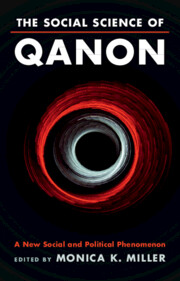Book contents
- The Social Science of QAnon
- The Social Science of QAnon
- Copyright page
- Dedication
- Contents
- Contributors
- Preface
- Part I Introduction to QAnon
- Part II Recruiting and Maintaining Followers
- Part III QAnon and Society
- Part IV The Role of Communication in Promoting and Limiting QAnon Support
- Chapter 12 QAnon and Social Media
- Chapter 13 Social Network Analysis Techniques Using NodeXL for Analyzing Disinformation Related to QAnon
- Chapter 14 QAnon, Folklore, and Conspiratorial Consensus
- Chapter 15 Debunking and Preventing Conspiracies
- Part V The Future of QAnon
- Index
- References
Chapter 13 - Social Network Analysis Techniques Using NodeXL for Analyzing Disinformation Related to QAnon
from Part IV - The Role of Communication in Promoting and Limiting QAnon Support
Published online by Cambridge University Press: 14 September 2023
- The Social Science of QAnon
- The Social Science of QAnon
- Copyright page
- Dedication
- Contents
- Contributors
- Preface
- Part I Introduction to QAnon
- Part II Recruiting and Maintaining Followers
- Part III QAnon and Society
- Part IV The Role of Communication in Promoting and Limiting QAnon Support
- Chapter 12 QAnon and Social Media
- Chapter 13 Social Network Analysis Techniques Using NodeXL for Analyzing Disinformation Related to QAnon
- Chapter 14 QAnon, Folklore, and Conspiratorial Consensus
- Chapter 15 Debunking and Preventing Conspiracies
- Part V The Future of QAnon
- Index
- References
Summary
Researchers have investigated how disinformation and fake news spreads through social networks. Understanding how disinformation flows on social networks can help identify interventions to reduce the impact of such falsehoods and prevent negative consequences that can result from following conspiracy theories. This chapter will provide an overview of how researchers can use the tool NodeXL to rapidly analyse social media data related to QAnon by drawing upon social network analysis. NodeXL can be used to identify the shape of the network, key opinion leaders, and content related to discussions around QAnon. NodeXL was recently utilised to study disinformation networks surrounding COVID-19, such as the 5G and COVID-19 conspiracy and the ‘Film Your Hospital’ conspiracy. The chapter will also examine how the QAnon Twitter network compares to other Twitter networks. The chapter will then provide an insight into future potential research avenues that could be pursued by scholars working in this area.
- Type
- Chapter
- Information
- The Social Science of QAnonA New Social and Political Phenomenon, pp. 216 - 233Publisher: Cambridge University PressPrint publication year: 2023



